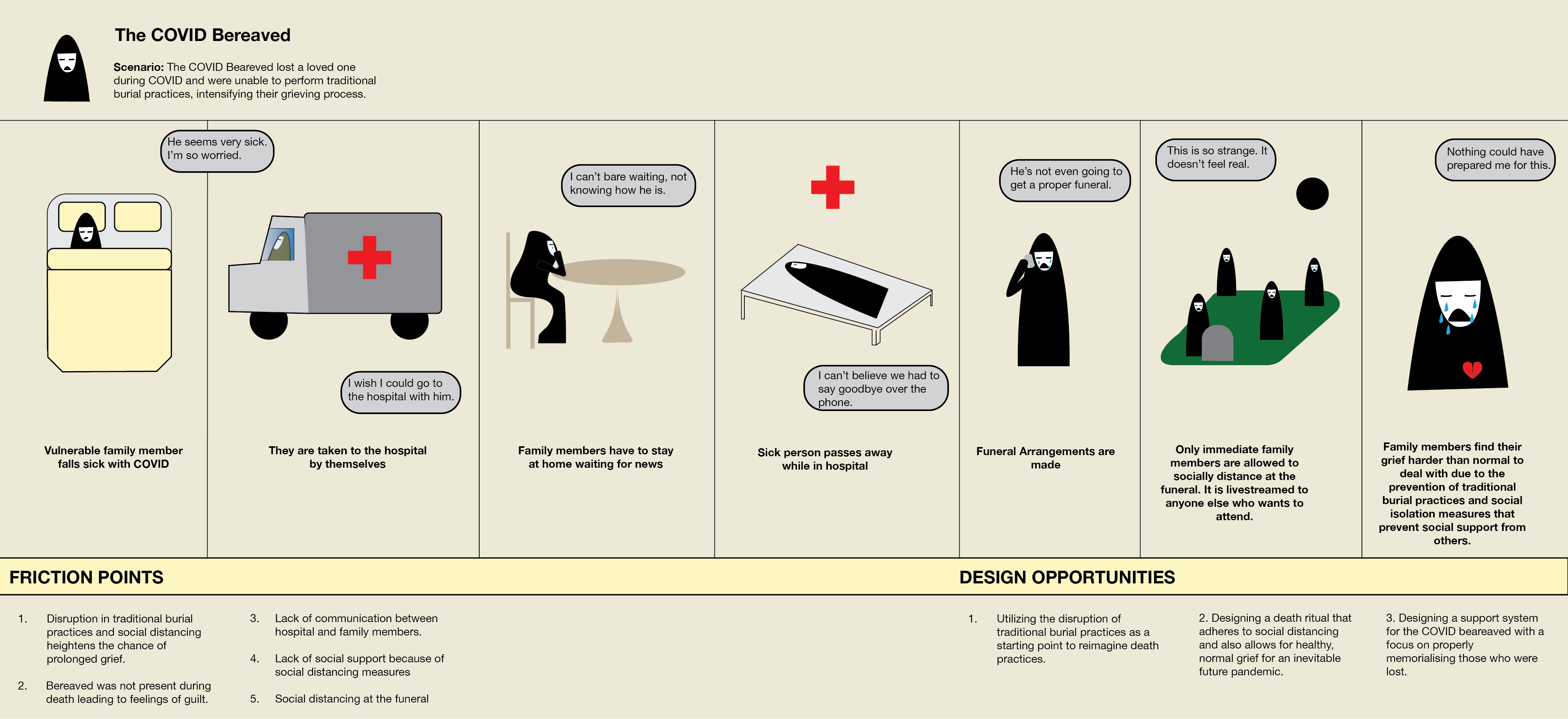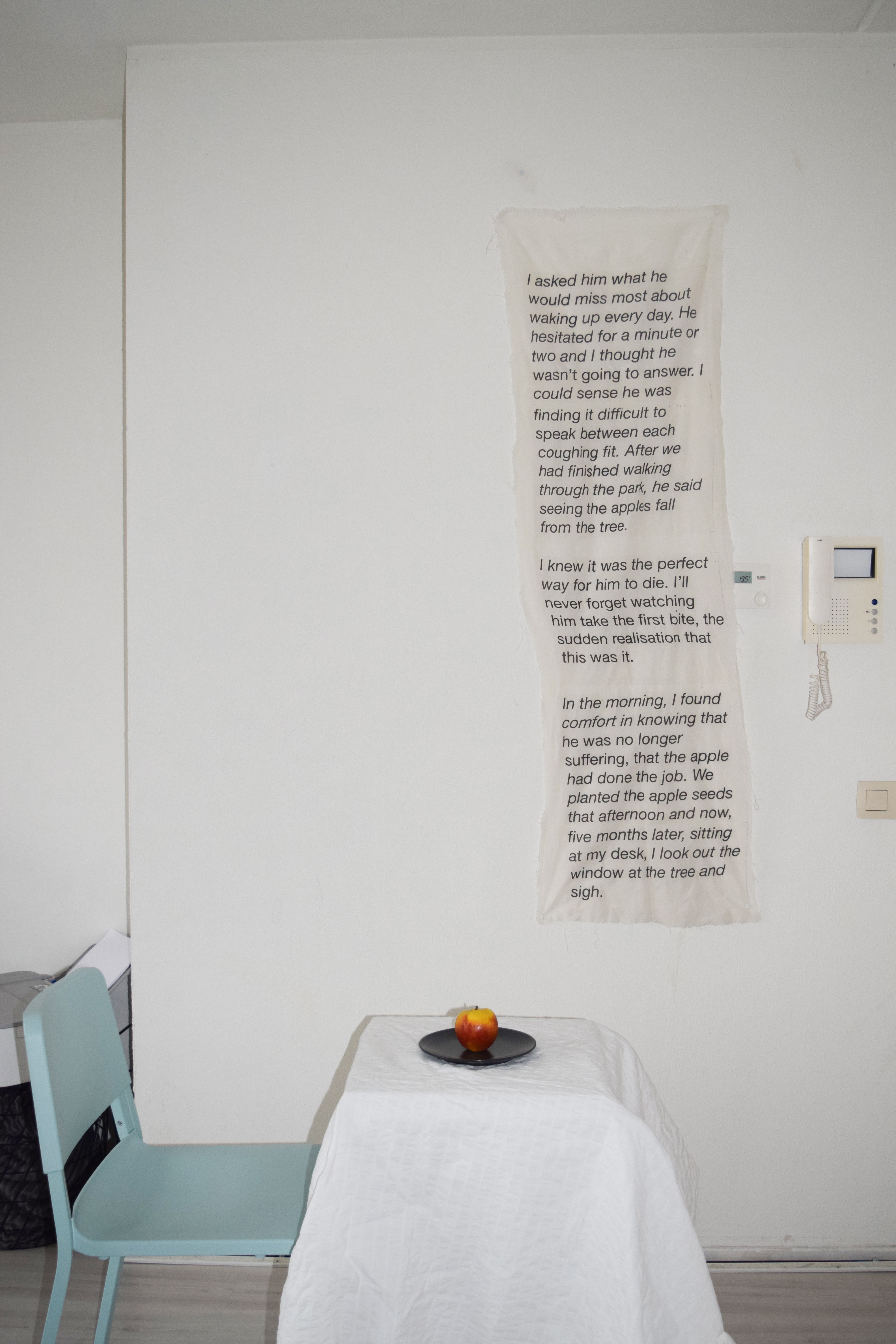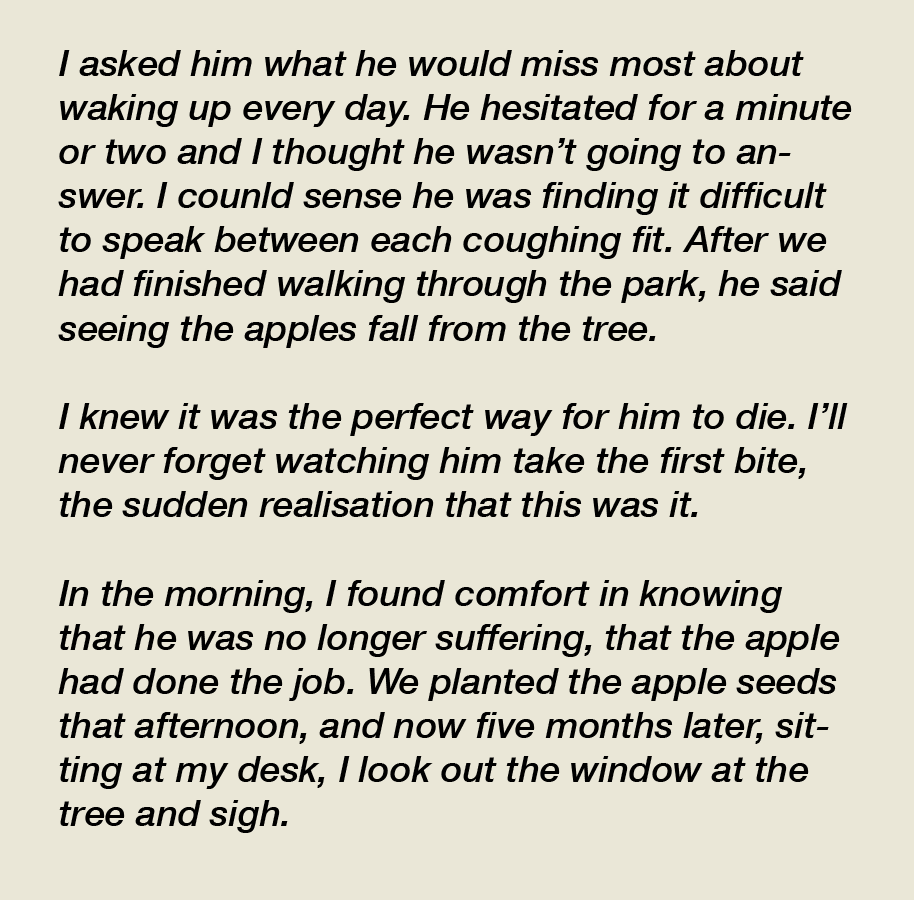

Poison Apple Installation View
Poison Apple
Redesigning Burial Practices
︎︎︎


Poison Apple Installation Images
Poison Apple Video
Design Academy Eindhoven
MA Contextual Design
Sept. - Dec. 2022
MA Contextual Design
Sept. - Dec. 2022
In Poison Apple: Redesigning Burial Practices, the apple is recontextualised from a benign object to one that is fear-inducing through the proposal of an end-of-life scenario in which the lethal
potential of the apple is exposed.
It is calculated that if a person of roughly 65 kg were to eat 200 apple seeds—the equivalent of 40 apples over a 24 hour time period— they would most likely die from cyanide poisoning. The toxicity of apple seeds results from the trace amounts of amygdalin that they contain. When the amygdalin comes into contact with the enzymes found in the small intestine, it converts into cyanide, a deadly chemical that has been used for mass suicide and warfare.
The installation consists of a lethal apple—one that contains 200 apple seeds—and an accompanying narrative. The narrative, told from the perspective of an unknown person, describes this person’s experience dealing with life after a close male-figure decides to terminate his life by eating the lethal apple. It is unclear what the man is suffering from, but we get the sense that he is at peace with his decision.
The pandemic robbed many of the chance to say goodbye to their loved ones. This prevention of burial practices increased the chances of a person developing Prolonged Grief Disorder (PGD), a disorder in which a person is unable to accept that their loved one has died, keeping them in a state of grief, unable to perform basic tasks.
Through the depiction of an absurd, possible future, in which death is an intimate affair and the dying person has agency, the project reclaims the COVID experience in which traditional death practices were indefinitely paused. In Poison Apple, this disruption is used as a starting point to imagine positive death rituals and how biotechnology might aid in creating a gentler death.
It is calculated that if a person of roughly 65 kg were to eat 200 apple seeds—the equivalent of 40 apples over a 24 hour time period— they would most likely die from cyanide poisoning. The toxicity of apple seeds results from the trace amounts of amygdalin that they contain. When the amygdalin comes into contact with the enzymes found in the small intestine, it converts into cyanide, a deadly chemical that has been used for mass suicide and warfare.
The installation consists of a lethal apple—one that contains 200 apple seeds—and an accompanying narrative. The narrative, told from the perspective of an unknown person, describes this person’s experience dealing with life after a close male-figure decides to terminate his life by eating the lethal apple. It is unclear what the man is suffering from, but we get the sense that he is at peace with his decision.
The pandemic robbed many of the chance to say goodbye to their loved ones. This prevention of burial practices increased the chances of a person developing Prolonged Grief Disorder (PGD), a disorder in which a person is unable to accept that their loved one has died, keeping them in a state of grief, unable to perform basic tasks.
Through the depiction of an absurd, possible future, in which death is an intimate affair and the dying person has agency, the project reclaims the COVID experience in which traditional death practices were indefinitely paused. In Poison Apple, this disruption is used as a starting point to imagine positive death rituals and how biotechnology might aid in creating a gentler death.
Development
︎︎︎

Still Image from Video
The Brief
Poison Apple emerges from a project where students embarked on an ethnographic exploration of individuals' dreams. The project morphed into a self-guided journey, prompting me to delve into the disruption of conventional burial customs during COVID-19 and envisioning novel alternatives.
Objective
The main objective of Poison Apple is to investigate the potential ramifications of challenging established burial norms. By immersing myself in the realm of dreams and leveraging ethnographic research into the experience of those who lost a loved one during COVID, I sought to unearth insights that could inform the speculative design of innovative burial practices.
Poison Apple emerges from a project where students embarked on an ethnographic exploration of individuals' dreams. The project morphed into a self-guided journey, prompting me to delve into the disruption of conventional burial customs during COVID-19 and envisioning novel alternatives.
Objective
The main objective of Poison Apple is to investigate the potential ramifications of challenging established burial norms. By immersing myself in the realm of dreams and leveraging ethnographic research into the experience of those who lost a loved one during COVID, I sought to unearth insights that could inform the speculative design of innovative burial practices.

User Experience Journey
Research
Through a combination of desk and ethnographic research including a series of interviews with those who had lost a loved one during COVID, as well as, my own personal experience attending a Zoom Funeral, I developed a User Journey depicting the experience of losing a loved one to COVID.
This allowed me to identify friction points such as the consequences of the prevention of traditional burial practices and its effect on the development of Prolonged Grief Disorder.
Design Opportunities
Through my interviews, it became clear that many sought a positive amidst the darkness of their experiences, prompting discussions on how the disruption of traditional burial practices during COVID-19 could serve as a catalyst for redefining mourning processes and crafting new rituals in alignment with advancements in biotechnology.
Through a combination of desk and ethnographic research including a series of interviews with those who had lost a loved one during COVID, as well as, my own personal experience attending a Zoom Funeral, I developed a User Journey depicting the experience of losing a loved one to COVID.
This allowed me to identify friction points such as the consequences of the prevention of traditional burial practices and its effect on the development of Prolonged Grief Disorder.
Design Opportunities
Through my interviews, it became clear that many sought a positive amidst the darkness of their experiences, prompting discussions on how the disruption of traditional burial practices during COVID-19 could serve as a catalyst for redefining mourning processes and crafting new rituals in alignment with advancements in biotechnology.

Development
While consolidating my research on COVID death practices, I became intrigued by the heightened sense of fear permeating society due to our collective experiences. Everyday encounters, once mundane, such as grocery shopping or passing by others, now induced a sense of dread and vigilance for fear of contagion.
In crafting the ritual, I aimed to capture this transformation of the ordinary into a reminder of one’s own mortality. This led me to explore the inherent dualities within commonplace materials, foods, and objects, considering how slight genetic alterations could render them lethal. It was during this research, that I came across the following hypothesis: “If a person of 65 kg were to eat 200 apple seeds, they would die of cyanide poisoning”.
Recognizing the symbolic significance of the apple, I decided to center a speculative death ritual around this iconic fruit.
Prototyping
As I started prototyping, I encountered the challenge of determining the portrayal of this design scenario. I went back-and-forth between a fantastical representation and one grounded in reality. It wasn't until I reconnected with the individuals I had interviewed initially that I recognized the project's value--that the foundation of my proposal lay in truth, and with proper engineering, it could exist. This realization allowed me to progress with the project both conceptually and aesthetically.
While consolidating my research on COVID death practices, I became intrigued by the heightened sense of fear permeating society due to our collective experiences. Everyday encounters, once mundane, such as grocery shopping or passing by others, now induced a sense of dread and vigilance for fear of contagion.
In crafting the ritual, I aimed to capture this transformation of the ordinary into a reminder of one’s own mortality. This led me to explore the inherent dualities within commonplace materials, foods, and objects, considering how slight genetic alterations could render them lethal. It was during this research, that I came across the following hypothesis: “If a person of 65 kg were to eat 200 apple seeds, they would die of cyanide poisoning”.
Recognizing the symbolic significance of the apple, I decided to center a speculative death ritual around this iconic fruit.
Prototyping
As I started prototyping, I encountered the challenge of determining the portrayal of this design scenario. I went back-and-forth between a fantastical representation and one grounded in reality. It wasn't until I reconnected with the individuals I had interviewed initially that I recognized the project's value--that the foundation of my proposal lay in truth, and with proper engineering, it could exist. This realization allowed me to progress with the project both conceptually and aesthetically.

Apple Prototypes
![]()



Prototyping the Ritual
![]()



Designing the Final Prototype
︎︎︎

Designing the final floorplan



 Making the final apple
Making the final apple Film Narrative
Film NarrativeConclusion
Ultimately, my deliverables were (1) a lethal apple made of 200 apple seeds and (2) an accompanying short film that explores the poetic ritual of consuming the Apple told from the perspective of an unknown grieving person. The narrative describes this person’s experience dealing with life after a close male-figure decides to terminate his life by eating the lethal apple. It is unclear what the man is suffering from, but we get the sense he is at peace with his decision.
This project often carried a weight, particularly during the initial stages when conducting ethnographic interviews with individuals who had experienced the loss of a loved one to COVID. However, I remained committed to maintaining communication with the interviewees by providing them with regular updates throughout the project.
Reflecting on the feedback from project participants, such as one remarking that "the project is beautifully layered," I feel confident that I achieved the objectives I set out to accomplish.
Continuation
I have recently been awarded a Stimuleringsfonds for this project from the Dutch Creative Fund to continue working on it and to exhibit it at Salone de Mobile 2024.
Ultimately, my deliverables were (1) a lethal apple made of 200 apple seeds and (2) an accompanying short film that explores the poetic ritual of consuming the Apple told from the perspective of an unknown grieving person. The narrative describes this person’s experience dealing with life after a close male-figure decides to terminate his life by eating the lethal apple. It is unclear what the man is suffering from, but we get the sense he is at peace with his decision.
This project often carried a weight, particularly during the initial stages when conducting ethnographic interviews with individuals who had experienced the loss of a loved one to COVID. However, I remained committed to maintaining communication with the interviewees by providing them with regular updates throughout the project.
Reflecting on the feedback from project participants, such as one remarking that "the project is beautifully layered," I feel confident that I achieved the objectives I set out to accomplish.
Continuation
I have recently been awarded a Stimuleringsfonds for this project from the Dutch Creative Fund to continue working on it and to exhibit it at Salone de Mobile 2024.